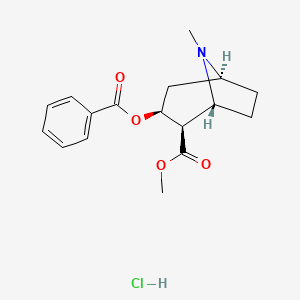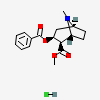Cocaine Hydrochloride
- COCAINE HYDROCHLORIDE
- 53-21-4
- Cocaine HCl
- Cocaine muriate
- Cocain-chlorhydrat
- Create:2005-06-24
- Modify:2025-01-18

- Cocaine
- Cocaine HCl
- Cocaine Hydrochloride
- HCl, Cocaine
- Hydrochloride, Cocaine
- COCAINE HYDROCHLORIDE
- 53-21-4
- Cocaine HCl
- Cocaine muriate
- Cocain-chlorhydrat
- Cocainum muriaticum
- Cocaine chloride
- Sal de merck
- Cocaine hydrochloride cii
- UNII-XH8T8T6WZH
- XH8T8T6WZH
- NSC 25263
- l-Cocaine hydrochloride
- GOPRELTO
- NUMBRINO
- MCV 4526
- NIH 8211
- EINECS 200-167-1
- NSC-25263
- DTXSID2048903
- RX-0041-002
- (-)-Cocaine hydrochloride
- CHEBI:613010
- Cocaine hydrochloride [USP:JAN]
- Methyl 3beta-hydroxy-1alphaH,5alphaH-tropan-2beta-carboxylate, benzoate (ester) hydrochloride
- 1alpha-H,5alpha-H-Tropane-2beta-carboxylic acid, 3beta-hydroxy-,
- Methyl 3-beta-hydroxy-1-alpha-H,5-alpha-H-tropan-2-beta-carboxylate, benzoate (ester) HCl
- methyl (1R,2R,3S,5S)-3-benzoyloxy-8-methyl-8-azabicyclo[3.2.1]octane-2-carboxylate;hydrochloride
- Cocaine hydrochloride (USP:JAN)
- COCAINE HYDROCHLORIDE (MART.)
- COCAINE HYDROCHLORIDE [MART.]
- COCAINE.HCL
- 1-alpha-H,5-alpha-H-Tropane-2-beta-carboxylic acid, 3-beta-hydroxy-, methyl ester, benzoate (ester), hydrochloride
- 1alphaH,5alphaH-Tropane-2beta-carboxylic acid, 3beta-hydroxy-, methyl ester, benzoate (ester), hydrochloride
- 8-AZABICYCLO(3.2.1)OCTANE-2-CARBOXYLIC ACID, 3-(BENZOYLOXY)-8-METHYL-, METHYL ESTER, HYDROCHLORIDE (1:1), (1R,2R,3S,5S)-
- 8-AZABICYCLO(3.2.1)OCTANE-2-CARBOXYLIC ACID, 3-(BENZOYLOXY)-8-METHYL-, METHYL ESTER, HYDROCHLORIDE, (1R,2R,3S,5S)
- 8-AZABICYCLO(3.2.1)OCTANE-2-CARBOXYLIC ACID, 3-(BENZOYLOXY)-8-METHYL-, METHYL ESTER, HYDROCHLORIDE,(1R-(EXO,EXO))-
- METHYL (1R,2R,3S,5S)-3-(BENZOYLOXY)-8-METHYL-8-AZABICYCLO(3.2.1) OCTANE-2-CARBOXYLATE HYDROCHLORIDE
- COCAINE HYDROCHLORIDE CII (USP-RS)
- COCAINE HYDROCHLORIDE CII [USP-RS]
- COCAINE HYDROCHLORIDE (EP MONOGRAPH)
- COCAINE HYDROCHLORIDE [EP MONOGRAPH]
- COCAINE HYDROCHLORIDE (USP MONOGRAPH)
- COCAINE HYDROCHLORIDE [USP MONOGRAPH]
- Cocaine Hydrochloride (1.0 mg/ml in Methanol)
- Cocaine Hydrochloride (1.0mg/ml in Acetonitrile)
- Cocain-chlorhydrat [German]
- Cocaine hydrochloride [JAN]
- NSC25263
- HCl, Cocaine
- 8-Azabicyclo(3.2.1)octane-2-carboxylic acid, 3-(benzoyloxy)-8-methyl-, methyl ester, hydrochloride, (1R-(exo,exo))-
- 8-Azabicyclo[3.2.1]octane-2-carboxylic acid, 3-(benzoyloxy)-8-methyl-, methyl ester, hydrochloride (1:1), (1R,2R,3S,5S)-
- Hydrochloride, Cocaine
- (1R,2R,3S,5S)-3-(benzoyloxy)-2-(methoxycarbonyl)-8-methyl-8-azoniabicyclo(3.2.1)octane chloride
- NCGC00159467-03
- cocaine hydrochloride nasal
- SCHEMBL186755
- CHEMBL529437
- DTXCID5028829
- COCAINE HYDROCHLORIDE [MI]
- COCAINUM MURIATICUM [HPUS]
- Tox21_112883
- COCAINE HYDROCHLORIDE [VANDF]
- AKOS024457309
- COCAINE HYDROCHLORIDE [WHO-DD]
- CAS-53-21-4
- Cocaine hydrochloride, analytical standard
- COCAINE HYDROCHLORIDE [ORANGE BOOK]
- NS00078986
- Cocaine.HCl, 1mg/ml in Methanol (as free base)
- Q27225784
- Cocaine hydrochloride, United States Pharmacopeia (USP) Reference Standard
- (1R,2R,3S,5S)-2-Methoxycarbonyl-8-methyl-8-azabicyclo(3.2.1)oct-3-yl benzoate monohydrochloride
 Cocaine (has active moiety)
Cocaine (has active moiety)


H301 (86.8%): Toxic if swallowed [Danger Acute toxicity, oral]
H317 (79.2%): May cause an allergic skin reaction [Warning Sensitization, Skin]
H319 (20.8%): Causes serious eye irritation [Warning Serious eye damage/eye irritation]
H360 (84.9%): May damage fertility or the unborn child [Danger Reproductive toxicity]
P203, P261, P264, P264+P265, P270, P272, P280, P301+P316, P302+P352, P305+P351+P338, P318, P321, P330, P333+P317, P337+P317, P362+P364, P405, and P501
(The corresponding statement to each P-code can be found at the GHS Classification page.)
Aggregated GHS information provided per 53 reports by companies from 9 notifications to the ECHA C&L Inventory. Each notification may be associated with multiple companies.
Information may vary between notifications depending on impurities, additives, and other factors. The percentage value in parenthesis indicates the notified classification ratio from companies that provide hazard codes. Only hazard codes with percentage values above 10% are shown.
Acute Tox. 3 (86.8%)
Skin Sens. 1 (79.2%)
Eye Irrit. 2 (20.8%)
Repr. 1B (84.9%)
Patents are available for this chemical structure:
https://patentscope.wipo.int/search/en/result.jsf?inchikey=PIQVDUKEQYOJNR-VZXSFKIWSA-N
- CAS Common ChemistryLICENSEThe data from CAS Common Chemistry is provided under a CC-BY-NC 4.0 license, unless otherwise stated.https://creativecommons.org/licenses/by-nc/4.0/(-)-Cocaine hydrochloridehttps://commonchemistry.cas.org/detail?cas_rn=53-21-4
- ChemIDplusCocaine hydrochloride [USP:JAN]https://pubchem.ncbi.nlm.nih.gov/substance/?source=chemidplus&sourceid=0000053214ChemIDplus Chemical Information Classificationhttps://pubchem.ncbi.nlm.nih.gov/source/ChemIDplus
- EPA DSSTox(-)-Cocaine hydrochloridehttps://comptox.epa.gov/dashboard/DTXSID2048903CompTox Chemicals Dashboard Chemical Listshttps://comptox.epa.gov/dashboard/chemical-lists/
- European Chemicals Agency (ECHA)LICENSEUse of the information, documents and data from the ECHA website is subject to the terms and conditions of this Legal Notice, and subject to other binding limitations provided for under applicable law, the information, documents and data made available on the ECHA website may be reproduced, distributed and/or used, totally or in part, for non-commercial purposes provided that ECHA is acknowledged as the source: "Source: European Chemicals Agency, http://echa.europa.eu/". Such acknowledgement must be included in each copy of the material. ECHA permits and encourages organisations and individuals to create links to the ECHA website under the following cumulative conditions: Links can only be made to webpages that provide a link to the Legal Notice page.https://echa.europa.eu/web/guest/legal-noticeCocaine hydrochloridehttps://echa.europa.eu/substance-information/-/substanceinfo/100.000.153Cocaine hydrochloride (EC: 200-167-1)https://echa.europa.eu/information-on-chemicals/cl-inventory-database/-/discli/details/10553
- FDA Global Substance Registration System (GSRS)LICENSEUnless otherwise noted, the contents of the FDA website (www.fda.gov), both text and graphics, are not copyrighted. They are in the public domain and may be republished, reprinted and otherwise used freely by anyone without the need to obtain permission from FDA. Credit to the U.S. Food and Drug Administration as the source is appreciated but not required.https://www.fda.gov/about-fda/about-website/website-policies#linkingCOCAINE HYDROCHLORIDEhttps://gsrs.ncats.nih.gov/ginas/app/beta/substances/XH8T8T6WZH
- New Zealand Environmental Protection Authority (EPA)LICENSEThis work is licensed under the Creative Commons Attribution-ShareAlike 4.0 International licence.https://www.epa.govt.nz/about-this-site/general-copyright-statement/
- ChEMBLLICENSEAccess to the web interface of ChEMBL is made under the EBI's Terms of Use (http://www.ebi.ac.uk/Information/termsofuse.html). The ChEMBL data is made available on a Creative Commons Attribution-Share Alike 3.0 Unported License (http://creativecommons.org/licenses/by-sa/3.0/).http://www.ebi.ac.uk/Information/termsofuse.htmlChEMBL Protein Target Treehttps://www.ebi.ac.uk/chembl/g/#browse/targets
- ClinicalTrials.govLICENSEThe ClinicalTrials.gov data carry an international copyright outside the United States and its Territories or Possessions. Some ClinicalTrials.gov data may be subject to the copyright of third parties; you should consult these entities for any additional terms of use.https://clinicaltrials.gov/ct2/about-site/terms-conditions#Use
- DailyMed
- Drug Gene Interaction database (DGIdb)LICENSEThe data used in DGIdb is all open access and where possible made available as raw data dumps in the downloads section.http://www.dgidb.org/downloadsCOCAINE HYDROCHLORIDEhttps://www.dgidb.org/drugs/rxcui:81985
- Drugs@FDALICENSEUnless otherwise noted, the contents of the FDA website (www.fda.gov), both text and graphics, are not copyrighted. They are in the public domain and may be republished, reprinted and otherwise used freely by anyone without the need to obtain permission from FDA. Credit to the U.S. Food and Drug Administration as the source is appreciated but not required.https://www.fda.gov/about-fda/about-website/website-policies#linkingCOCAINE HYDROCHLORIDEhttps://www.accessdata.fda.gov/scripts/cder/daf/
- EU Clinical Trials Register
- FDA Orange BookLICENSEUnless otherwise noted, the contents of the FDA website (www.fda.gov), both text and graphics, are not copyrighted. They are in the public domain and may be republished, reprinted and otherwise used freely by anyone without the need to obtain permission from FDA. Credit to the U.S. Food and Drug Administration as the source is appreciated but not required.https://www.fda.gov/about-fda/about-website/website-policies#linking
- National Drug Code (NDC) DirectoryLICENSEUnless otherwise noted, the contents of the FDA website (www.fda.gov), both text and graphics, are not copyrighted. They are in the public domain and may be republished, reprinted and otherwise used freely by anyone without the need to obtain permission from FDA. Credit to the U.S. Food and Drug Administration as the source is appreciated but not required.https://www.fda.gov/about-fda/about-website/website-policies#linkingCOCAINE HYDROCHLORIDEhttps://www.fda.gov/drugs/drug-approvals-and-databases/national-drug-code-directory
- NCI Thesaurus (NCIt)LICENSEUnless otherwise indicated, all text within NCI products is free of copyright and may be reused without our permission. Credit the National Cancer Institute as the source.https://www.cancer.gov/policies/copyright-reuseNCI Thesaurushttps://ncit.nci.nih.gov
- Open TargetsLICENSEDatasets generated by the Open Targets Platform are freely available for download.https://platform-docs.opentargets.org/licenceCOCAINE HYDROCHLORIDEhttps://platform.opentargets.org/drug/CHEMBL529437
- NLM RxNorm TerminologyLICENSEThe RxNorm Terminology is created by the National Library of Medicine (NLM) and is in the public domain and may be republished, reprinted and otherwise used freely by anyone without the need to obtain permission from NLM. Credit to the U.S. National Library of Medicine as the source is appreciated but not required. The full RxNorm dataset requires a free license.https://www.nlm.nih.gov/research/umls/rxnorm/docs/termsofservice.htmlcocaine hydrochloridehttps://rxnav.nlm.nih.gov/id/rxnorm/81985
- SpectraBaseCocaine hydrochloridehttps://spectrabase.com/spectrum/8OtpWM6hLJKCocaine hydrochloridehttps://spectrabase.com/spectrum/CburnL8ExZzCOCAINHYDROCHLORIDEhttps://spectrabase.com/spectrum/1QocAjortNECocaine hydrochloridehttps://spectrabase.com/spectrum/5jIT6iUTRauCocaine hydrochloridehttps://spectrabase.com/spectrum/2L69p1oqDam
- Springer Nature
- Wikidatacocaine hydrochloridehttps://www.wikidata.org/wiki/Q27225784
- Medical Subject Headings (MeSH)LICENSEWorks produced by the U.S. government are not subject to copyright protection in the United States. Any such works found on National Library of Medicine (NLM) Web sites may be freely used or reproduced without permission in the U.S.https://www.nlm.nih.gov/copyright.htmlAnesthetics, Localhttps://www.ncbi.nlm.nih.gov/mesh/68000779Dopamine Uptake Inhibitorshttps://www.ncbi.nlm.nih.gov/mesh/68018765Vasoconstrictor Agentshttps://www.ncbi.nlm.nih.gov/mesh/68014662
- PubChem
- GHS Classification (UNECE)GHS Classification Treehttp://www.unece.org/trans/danger/publi/ghs/ghs_welcome_e.html
- NORMAN Suspect List ExchangeLICENSEData: CC-BY 4.0; Code (hosted by ECI, LCSB): Artistic-2.0https://creativecommons.org/licenses/by/4.0/NORMAN Suspect List Exchange Classificationhttps://www.norman-network.com/nds/SLE/
- EPA Substance Registry ServicesEPA SRS List Classificationhttps://sor.epa.gov/sor_internet/registry/substreg/LandingPage.do
- MolGenieMolGenie Organic Chemistry Ontologyhttps://github.com/MolGenie/ontology/
- PATENTSCOPE (WIPO)SID 388338969https://pubchem.ncbi.nlm.nih.gov/substance/388338969
- NCBI


 CID 313 (Hydrochloric Acid)
CID 313 (Hydrochloric Acid)